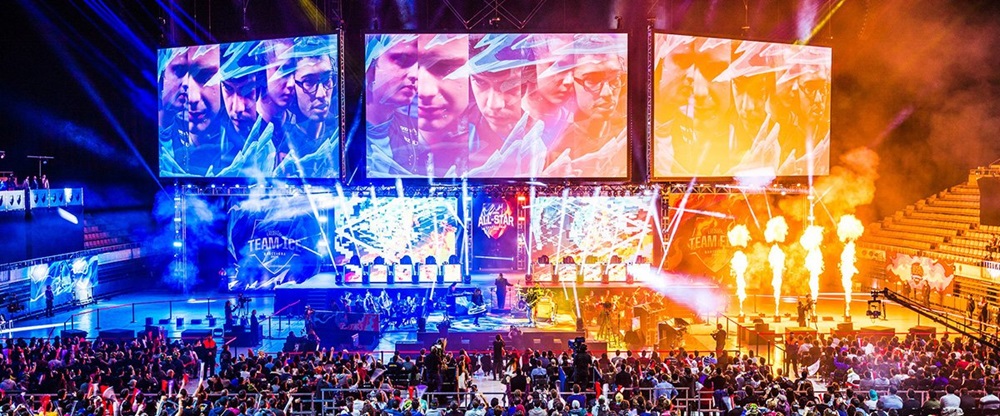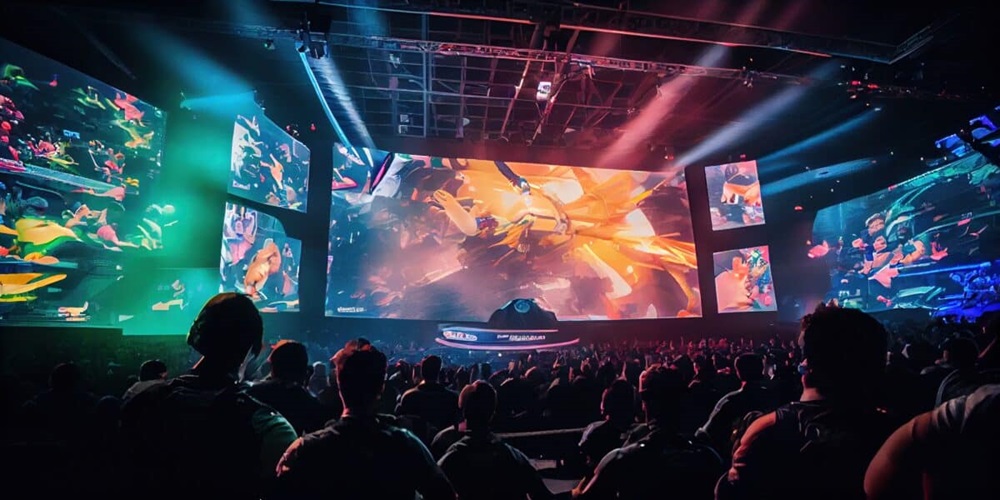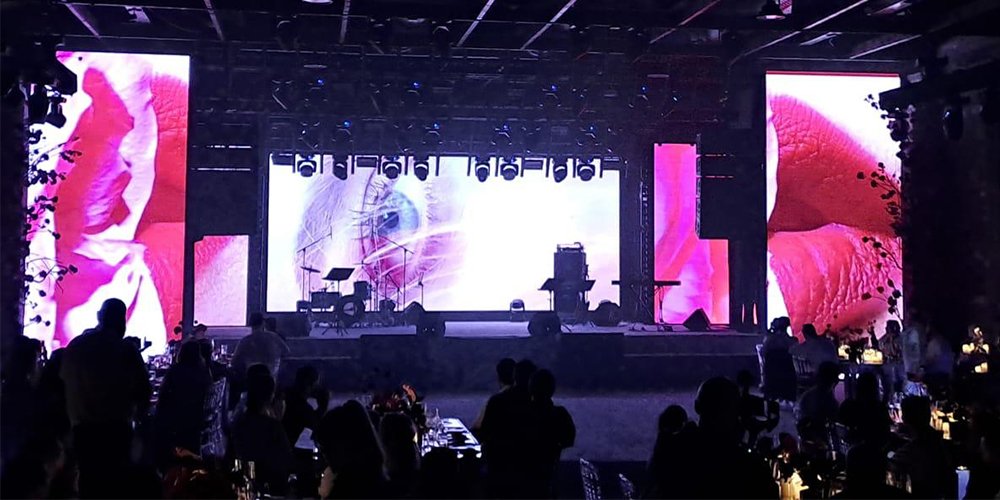Rental LED displays are an excellent option for attracting customers and audiences at a relatively low cost and with high efficiency. They can enhance your profits and boost your brand image. However, you might not be fully familiar with the specific functions and features of rental LED displays, or know when they are the best choice for your needs.
This article offers a comprehensive guide to rental LED displays, including their features, how to determine whether you need one, and how to choose the right model for your business. Our goal is to answer all your potential questions in one place—and we believe you’ll find it highly valuable.
1. What Is a Rental LED Display?
Let’s begin with a definition. You may be wondering about the difference between a “fixed LED display” and a “rental LED display.” As the names suggest, fixed LED displays are installed in permanent locations and cannot be easily moved, while rental LED displays are designed for temporary use at events like trade shows, concerts, and other public functions.
Rental LED display modules are easy to install and dismantle, lightweight for easy transport, and can be customized in height and width to match the overall LED video wall structure.
“LED screen rental” usually refers to renting large-format displays far bigger than any consumer electronics, intended for audiences of all sizes. These large displays are often called LED video walls, formed by assembling multiple LED display modules to create one seamless screen.
1.1 LED Screens vs. LED Video Walls
LED screens can be used to build video walls by connecting modules together in custom sizes or shapes, ensuring seamless image performance. LED video walls typically require special hardware and software to keep all modules working in sync, and customization is one of their standout features.
Large rental LED video walls often make a strong impression at major events.
1.2 Types of LED Displays
-
Outdoor – These displays are rainproof, sunproof, dustproof, lightning-resistant, and heat-resistant. They’re brighter and more durable than indoor screens, designed for long-distance viewing, but usually have lower pixel density.
-
Indoor – These displays use modular panels, offer higher resolution and finer pixel pitch for close-up viewing. Since they’re used indoors, they don’t need to be as bright or weather-resistant.
There’s also a semi-outdoor type, often installed under eaves or in covered open areas. While as bright as outdoor displays, they are not resistant to rain or harsh weather.
2. Is a Rental LED Display Right for You?
Now that you know what a rental LED display is, this section will help you determine if it’s the right solution for your event and how to choose the most suitable product.
2.1 Advantages of Rental LED Displays
-
Capture attention and deliver your message effectively
-
Generate revenue from sponsorships
-
Flexible sizing to suit your event space without buying new materials
-
Easy installation and transportation
Your three main AV rental options are rental LED screens, projector screens, and TVs/monitors. Let’s compare them.
2.2 Key Considerations
-
Is your event indoors or outdoors? Day or night?
-
If it’s at night or indoors, a projector may work.
-
But if someone walks between the projector and screen, it casts shadows, disrupting visuals.
-
-
Do you need weather resistance against rain, dust, or wind?
-
Do you need high-quality visuals for large crowds, even in daylight?
2.3 Key Technical Specifications to Consider
-
Pixel Pitch – Measured in mm, it’s the distance between two LEDs. It affects resolution and minimum viewing distance. Indoor displays require smaller pixel pitch than outdoor ones.
-
Resolution – Expressed as width × height in pixels (e.g., 1920x1080p). Higher resolution = better image quality for close viewing.
-
Brightness – Measured in nits. Outdoor screens need at least 4,500 nits to be visible in sunlight. Indoor displays only require 1,000–3,000 nits.
-
IP Rating – Measures resistance to dust and water.
-
Outdoor: Minimum IP65; IP68 in rainy areas
-
Indoor: Lower ratings like IP63 may suffice
-
2.4 Tips for Using Rental LED Displays
1) Choose a Reliable Supplier
Check reviews, ask about past projects, and avoid selecting purely based on the lowest price. Service and product quality matter, especially since LED display setup often requires expert assistance.
2) Book in Advance
Stock may be limited—early booking ensures availability for your event.
3) Get the Right Aspect Ratio
Match your content resolution to your screen ratio (e.g., 16:9). A higher resolution file doesn’t always mean better image quality—pick one that fits your screen specs.
4) Keep Content Clear
People prefer short, focused content. Use bold and concise messages for maximum impact.
5) Use Contrast
High contrast between foreground and background elements improves visibility, especially from a distance.
2.5 Rental LED Display Pricing
1) Resolution
Higher resolution = higher cost. Consider your pixel pitch, viewing distance, duration of use, and application.
2) Installation
The complexity of the installation project significantly affects the rental price. In some cases, it may be necessary to build a truss system to support deep LED screen setups. Additionally, labor costs are another key consideration—more complex installations and tighter schedules lead to higher labor expenses.
3) Rental Duration
The price generally decreases over time. The first day is usually the most expensive, while the cost for each subsequent day is typically around 20% of the first day’s rate.
3. Typical Application Scenarios
1) Stage Performances
The rental LED display market for stage performances has tremendous potential. Concerts, opening ceremonies, and variety shows are held all over the world. With high brightness and vibrant contrast, LED screens deliver an immersive visual experience. The combination of colorful visuals and flexible content switching creates a powerful visual impact and artistic appeal. These features make rental LED displays an essential element in stage performances.
Ideal for: Stages, concerts, and bars
2) Auto Shows
With the booming automotive market, car exhibitions have become a major platform for manufacturers to showcase their competitiveness. Today, it’s not just about the cars—LED displays have also taken center stage. A well-suited, high-performance LED screen can visually present a car’s design, functions, and technical features in detail, helping customers better understand product strengths and design concepts.
Benefit: Enhances compatibility with various car show environments
3) Hotels
As more companies host annual meetings, product launches, and appreciation events in hotels, LED display rentals in hotels have become a new industry trend. Many companies prefer venues equipped with LED screens, leading to increased rental demand. The growing market has also attracted more investor interest.
Benefit: Offers multiple advantages for corporate events
4) Television Broadcasting
As one of the fastest-growing industries in information technology, television broadcasting increasingly relies on digital applications. The demand for indoor rental LED screens in TV studios continues to rise. These screens can deliver stunning background visuals and enable more interactive and dynamic broadcasts.
Use case: Brightens and energizes the studio setting
5) Weddings
Weddings are among life’s most memorable moments, and audiovisual elements play a vital role in creating a heartwarming atmosphere. LED screen rentals are especially important in this context. Projectors often cast images onto the audience, diminishing the overall ambiance, while rented TVs tend to be too small for large venues.
Benefit: Creates a beautiful and romantic wedding environment
6) Sporting Events
If you want your audience to view the game from all angles or clearly follow the action, a rental LED display is the ideal solution. For outdoor events, live footage can be captured by cameras and displayed on the big screen. Given that sports events often face unstable environments—rain, dust, long-distance viewing—LED displays are well-equipped to handle these challenges.
Use case: Perfect for outdoor sports viewing and instant replay
7) Clubs / DJ Events
Whether it’s a large party or a debut performance by a club band, rental LED screens can effectively convey energy and information by merging sound and visuals. For DJ events (also called EDM festivals), a highly charged atmosphere is key to success. LED displays help achieve this by creating an immersive environment.
Content possibilities: Sponsor videos, gaming visuals, live feeds, safety alerts, navigation signs, advertisements—virtually anything you want to display can be shown through a rental LED wall.
4. Development Trends
The development of rental LED displays dates back more than a decade. In 2020, the COVID-19 pandemic hit the global economy hard, significantly reducing revenues across industries. Renting LED displays emerged as a budget-saving alternative to purchasing, helping clients meet their needs at lower costs and stimulating order volume. As the global market recovers, rental LED displays are expected to show several new trends:
1) Narrow Pixel Pitch Screens Will Gain More Market Share
With higher image quality requirements, more customers will opt for high-definition rental LED screens designed for close viewing. Although such screens require more advanced technology, increased adoption may drive down prices.
According to Chinese government guidelines for the LED industry, by 2022, a 4K ecosystem was to be established, and breakthroughs in 8K core technologies were expected—further boosting the competitiveness of China’s LED module exports.
2) Compatibility Across More Environments
Currently, rental LED displays are mainly used in stadiums, stages, conferences, weddings, and parks. Future applications will expand into areas like smart cities and intelligent factories. LED displays will become essential tools for connecting people with their environments, raising the bar for manufacturers in terms of precision and standards.
3) Lighter and Thinner Cabinets
Many rental LED screens today use magnesium alloy materials, making them lighter and thinner than traditional options. However, there is still room for improvement in terms of structural design, materials, and installation methods. As LED technology matures, we can expect even more lightweight, high-resolution, and advanced structural products.
4) Patent Protection Will Be Critical
Due to fierce market competition, many suppliers avoid investing in R&D and instead copy existing display technologies. This has led to several cases of intellectual property infringement. To maintain technological leadership, patent protection will become a top priority across the industry.
5) Standardization Will Become a Key Focus
There are currently hundreds of manufacturers producing rental LED screens, with inconsistent product quality, pricing, and design standards. This has resulted in unhealthy price competition and rampant product imitation. Standardization in production, sales, and services will be essential to solve these problems.
6) Rising Demand for Custom-Shaped Rental Displays
Creative-shaped LED screens—especially for stage applications—can deliver impressive visual effects. While demand for these customized displays is growing, the market remains relatively untapped. Companies that pioneer these unique solutions are likely to capture significant market share in the future.
Ultimate Guide to LED Display Rentals: All You Need to Know About LED Rental Screens
7) Clubs/DJ Events
Whether it’s a large party or a club band’s debut performance, rental LED displays help create an engaging atmosphere and effectively convey messages, as they are a medium that integrates sound and visuals. For DJ events (also known as electronic music festivals), a highly immersive atmosphere is a key factor in determining their success. That’s why LED screens play a vital role—they help fully immerse the audience in the experience.
The content displayed can be diverse, including sponsor videos, games, live camera feeds, safety alerts, directional signage, advertisements, and more. Nearly anything you want to show can be presented through a rental LED wall.
IV. Development Trends
The development of rental LED displays dates back more than a decade. In 2020, the global economy took a major hit due to the COVID-19 pandemic, causing a significant drop in revenue worldwide. As a result, renting LED screens became a cost-effective alternative to purchasing full equipment sets, helping clients save budget while boosting order volume. As the global market continues to recover, several key trends are expected to emerge in the rental LED display sector:
1) Small pixel pitch LED rental screens will gain more market share.
With increasing demand for high-resolution visuals, more customers are opting for rental LED screens with closer viewing distances and finer image quality. Although these screens may have higher technical requirements, their growing popularity is likely to drive prices down over time.
Additionally, according to guidance from the Chinese government on the domestic LED display industry, the 4K ecosystem will be gradually improved by 2022, and breakthroughs in 8K core technologies will enhance China’s competitiveness in exporting LED modules.
2) Rental LED displays will become compatible with more venues and environments.
Currently, rental LED displays are mainly used in stadiums, stages, conferences, weddings, parks, etc. In the future, their applications will expand to include smart cities, intelligent factories, and more. This trend will make LED displays a powerful tool for connecting people with their surroundings, and will place higher and more precise demands on manufacturers.
3) Cabinets will become lighter and thinner.
Although many current rental LED displays use magnesium alloy for lighter and thinner screens, there is still room for improvement in structure, raw materials, and installation methods. With ongoing LED technology advancements, we can expect more lightweight products with higher definition and more sophisticated designs in the future.
4) Patent protection will become a key issue.
Due to fierce competition in the LED market, many suppliers avoid investing in R&D in order to lower costs and win more orders, resulting in numerous cases of technology plagiarism. To maintain a competitive edge, patent protection will become a central focus for the entire industry.
5) More companies will pursue standardization across production, sales, and service.
Currently, there are hundreds of LED rental screen manufacturers, with great variations in product quality, pricing, design, and structure. The lack of uniform standards has led to unhealthy price competition and rampant plagiarism. Therefore, standardization will be an important trend to resolve these issues.
6) Demand for creative-shaped rental LED displays will continue to grow.
For example, the creative structures of stage rental screens can deliver a strong visual impact. Although demand is increasing, the market for irregular-shaped LED displays remains largely untapped. Whoever pioneers the development of such screens will be well-positioned to capture a larger market share in the future.
Post time: May-21-2025



